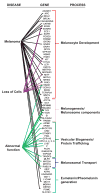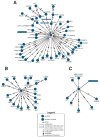Networks and pathways in pigmentation, health, and disease
- PMID: 20161540
- PMCID: PMC2804986
- DOI: 10.1002/wsbm.20
Networks and pathways in pigmentation, health, and disease
Abstract
Extensive studies of the biology of the pigment-producing cell (melanocyte) have resulted in a wealth of knowledge regarding the genetics and developmental mechanisms governing skin and hair pigmentation. The ease of identification of altered pigment phenotypes, particularly in mouse coat color mutants, facilitated early use of the pigmentary system in mammalian genetics and development. In addition to the large collection of developmental genetics data, melanocytes are of interest because their malignancy results in melanoma, a highly aggressive and frequently fatal cancer that is increasing in Caucasian populations worldwide. The genetic programs regulating melanocyte development, function, and malignancy are highly complex and only partially understood. Current research in melanocyte development and pigmentation is revealing new genes important in these processes and additional functions for previously known individual components. A detailed understanding of all the components involved in melanocyte development and function, including interactions with neighboring cells and response to environmental stimuli, will be necessary to fully comprehend this complex system. The inherent characteristics of pigmentation biology as well as the resources available to researchers in the pigment cell community make melanocytes an ideal cell type for analysis using systems biology approaches. In this review, the study of melanocyte development and pigmentation is considered as a candidate for systems biology-based analyses.
Keywords: development; genetics; melanocyte; melanoma; pigmentation.
Figures


Similar articles
-
Graying: gerontobiology of the hair follicle pigmentary unit.Exp Gerontol. 2001 Jan;36(1):29-54. doi: 10.1016/s0531-5565(00)00210-2. Exp Gerontol. 2001. PMID: 11162910 Review.
-
The cell biology of human hair follicle pigmentation.Pigment Cell Melanoma Res. 2011 Feb;24(1):75-88. doi: 10.1111/j.1755-148X.2010.00803.x. Epub 2010 Dec 6. Pigment Cell Melanoma Res. 2011. PMID: 21070612
-
Skin pigmentation and its control: From ultraviolet radiation to stem cells.Exp Dermatol. 2021 Apr;30(4):560-571. doi: 10.1111/exd.14260. Epub 2020 Dec 24. Exp Dermatol. 2021. PMID: 33320376 Free PMC article. Review.
-
Melanocyte stem cells as potential therapeutics in skin disorders.Expert Opin Biol Ther. 2014 Nov;14(11):1569-79. doi: 10.1517/14712598.2014.935331. Epub 2014 Aug 8. Expert Opin Biol Ther. 2014. PMID: 25104310 Free PMC article. Review.
-
Melanocyte development: with a message of encouragement to young women scientists.Pigment Cell Res. 2004 Oct;17(5):533-44. doi: 10.1111/j.1600-0749.2004.00163.x. Pigment Cell Res. 2004. PMID: 15357841 Review.
Cited by
-
Mining the 99 Lives Cat Genome Sequencing Consortium database implicates genes and variants for the Ticked locus in domestic cats (Felis catus).Anim Genet. 2021 Jun;52(3):321-332. doi: 10.1111/age.13059. Epub 2021 Mar 29. Anim Genet. 2021. PMID: 33780570 Free PMC article.
-
A molecular systems approach to modelling human skin pigmentation: identifying underlying pathways and critical components.BMC Res Notes. 2015 Apr 29;8:170. doi: 10.1186/s13104-015-1128-6. BMC Res Notes. 2015. PMID: 25925987 Free PMC article.
-
Functional Differentiation of BMP7 Genes in Zebrafish: bmp7a for Dorsal-Ventral Pattern and bmp7b for Melanin Synthesis and Eye Development.Front Cell Dev Biol. 2022 Mar 15;10:838721. doi: 10.3389/fcell.2022.838721. eCollection 2022. Front Cell Dev Biol. 2022. PMID: 35372349 Free PMC article.
-
The integrated analysis of RNA-seq and microRNA-seq depicts miRNA-mRNA networks involved in Japanese flounder (Paralichthys olivaceus) albinism.PLoS One. 2017 Aug 4;12(8):e0181761. doi: 10.1371/journal.pone.0181761. eCollection 2017. PLoS One. 2017. PMID: 28777813 Free PMC article.
-
Xenopus as a model system for studying pigmentation and pigmentary disorders.Pigment Cell Melanoma Res. 2025 Jan;38(1):e13178. doi: 10.1111/pcmr.13178. Epub 2024 Jun 7. Pigment Cell Melanoma Res. 2025. PMID: 38849973 Free PMC article. Review.
References
-
- Miyamura Y, Coelho SG, Wolber R, Miller SA, Wakamatsu K, Zmudzka BZ, Ito S, Smuda C, Passeron T, Choi W, Batzer J, Yamaguchi Y, Beer JZ, Hearing VJ. Regulation of human skin pigmentation and responses to ultraviolet radiation. Pigment Cell Res. 2007;20(1):2–13. - PubMed
-
- Hearing VJ. Biogenesis of pigment granules: a sensitive way to regulate melanocyte function. J Dermatol Sci. 2005;37(1):3–14. - PubMed
-
- Lang D, Lu MM, Huang L, Engleka KA, Zhang M, Chu EY, Lipner S, Skoultchi A, Millar SE, Epstein JA. Pax3 functions at a nodal point in melanocyte stem cell differentiation. Nature. 2005;433(7028):884–887. - PubMed
-
- Nishimura EK, Granter SR, Fisher DE. Mechanisms of hair graying: incomplete melanocyte stem cell maintenance in the niche. Science. 2005;307(5710):720–724. - PubMed
-
- Osawa M, Egawa G, Mak SS, Moriyama M, Freter R, Yonetani S, Beermann F, Nishikawa S. Molecular characterization of melanocyte stem cells in their niche. Development. 2005;132(24):5589–5599. - PubMed
Publication types
MeSH terms
Grants and funding
LinkOut - more resources
Full Text Sources
Other Literature Sources

